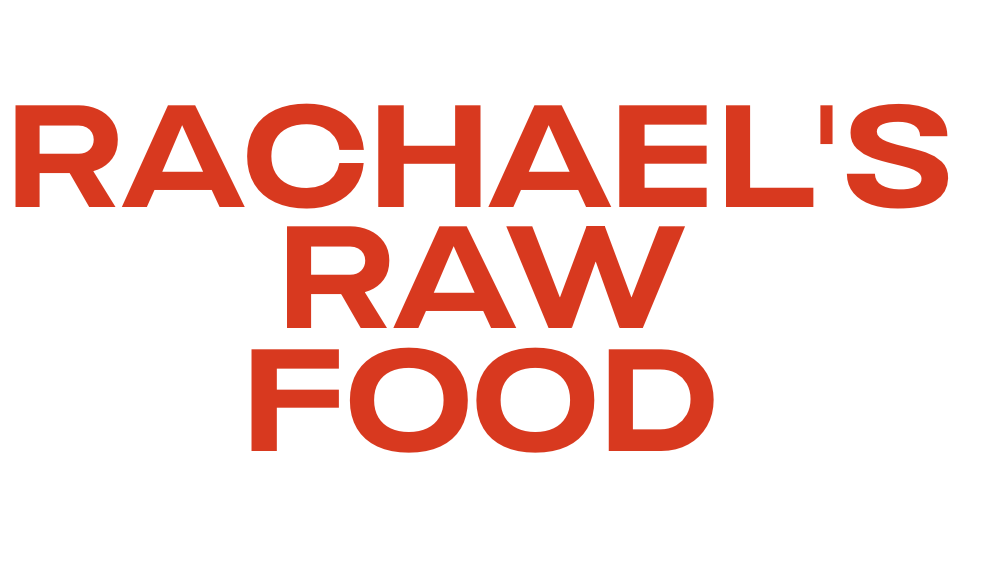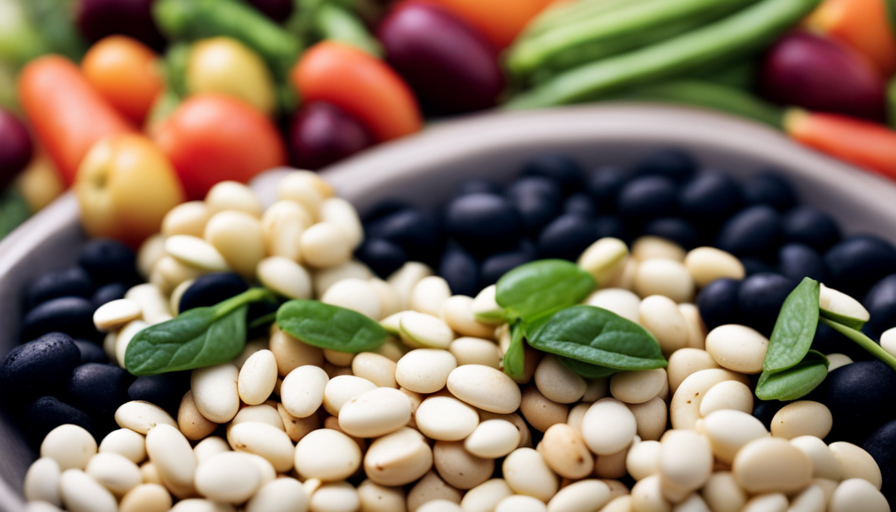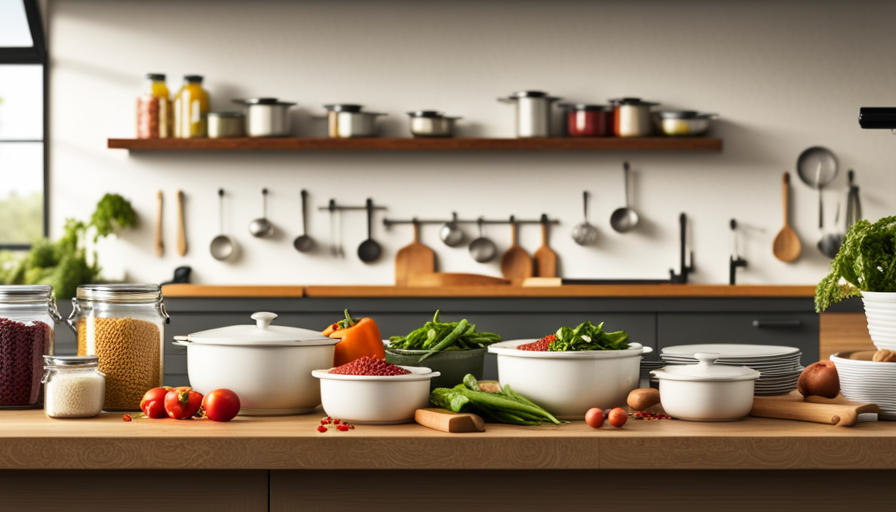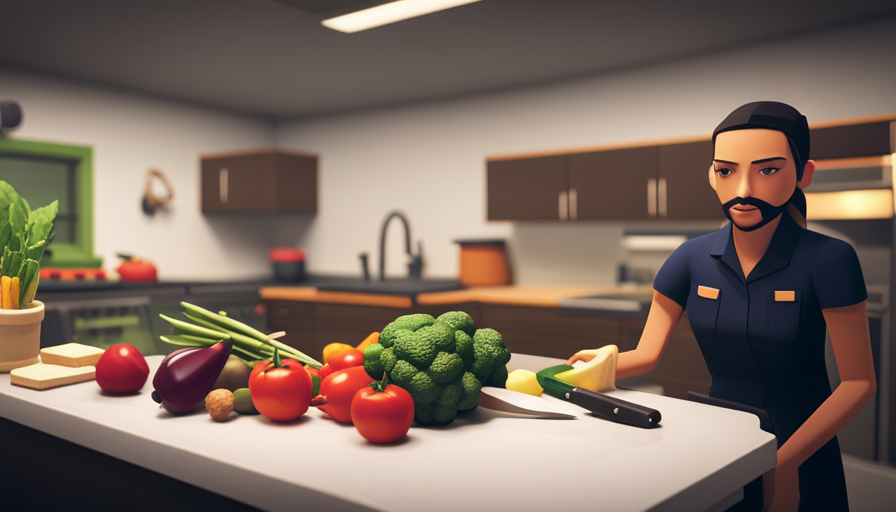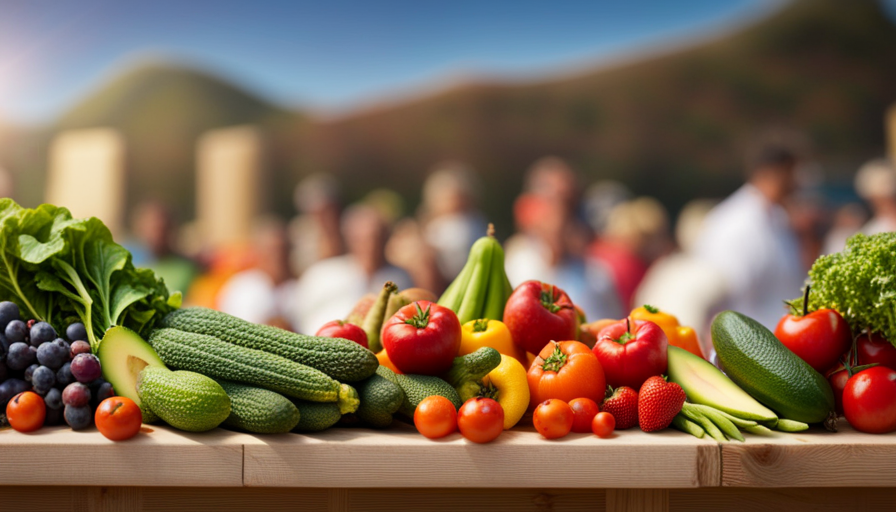Are you prepared to start a raw food journey that will nourish your body and please your palate? Get ready to uncover the secrets of incorporating this simple legume into your raw food diet.
Beans, known for their versatility and nutritional value, can be a delicious addition to your raw food lifestyle. In this article, we will guide you through the principles of a raw food diet and explore different protein sources, with a focus on beans.
Learn how to prepare beans for a raw food diet, from soaking to sprouting, and discover the art of creating mouthwatering bean dips, spreads, desserts, and snacks. Whether you’re a seasoned raw food enthusiast or just starting your journey, we’ve got you covered with tips and techniques for successfully incorporating beans into your raw food diet.
Get ready for a bean-tastic culinary adventure!
Key Takeaways
- Incorporate beans into raw food meals for a good source of protein, fiber, and important minerals.
- Sprout beans before consuming them to enhance digestion and nutrient absorption.
- Use beans in various ways, such as adding them to salads, soups, wraps, or blending them into dips and spreads.
- Explore bean-based desserts and snacks as a tasty way to include beans in a raw food diet.
The Benefits of a Raw Food Diet
Eating a raw food diet brings an array of incredible benefits that will leave you feeling energized and vibrant. One of the major advantages of this diet is weight loss. By consuming raw, unprocessed foods, you’re automatically cutting out unhealthy fats, sugars, and additives that can lead to weight gain.
Raw foods are also low in calories, making it easier for you to shed those extra pounds. Additionally, a raw food diet is great for detoxification. Raw fruits and vegetables are rich in fiber, which helps to cleanse your digestive system and eliminate toxins from your body. The enzymes present in raw foods also aid in detoxification by breaking down harmful substances.
Moreover, raw foods are packed with essential vitamins and minerals that nourish your body and boost your immune system. This diet can also improve your skin’s health and appearance. The high water content in raw foods keeps your skin hydrated and reduces the appearance of wrinkles.
Overall, incorporating a raw food diet into your lifestyle can have numerous positive effects on your health and well-being.
Understanding the Principles of a Raw Food Lifestyle
When following a raw food lifestyle, it’s important to grasp the core principles and beliefs that guide this way of living. Understanding the basics of a raw food diet can help you transition smoothly into this new way of eating.
One of the main principles of a raw food lifestyle is the belief that cooking food destroys its vital nutrients and enzymes. Raw foodists aim to consume food in its most natural state, believing that this promotes optimal health and vitality.
Transitioning to a raw food diet may seem challenging at first, but with proper knowledge and preparation, it can be a rewarding experience. Start by gradually incorporating more raw fruits, vegetables, nuts, and seeds into your meals. Experiment with different recipes and try new foods to keep your meals exciting and varied.
It’s also important to ensure that you are getting all the essential nutrients your body needs. Pay attention to your protein intake and consider including plant-based protein sources such as beans, lentils, and quinoa in your meals.
In addition to understanding the principles of a raw food lifestyle, it’s essential to listen to your body and make adjustments accordingly. Everyone’s body is unique, so it’s important to find what works best for you. Stay educated, stay curious, and enjoy the journey towards a healthier, more vibrant you.
Exploring Different Protein Sources on a Raw Food Diet
By incorporating a variety of plant-based protein sources like lentils, quinoa, and nuts, you can explore different options for nourishing your body on a raw food lifestyle. Protein is an essential component of any diet, and finding protein alternatives on a raw food diet can be both exciting and delicious. Here are three protein-rich options to consider:
-
Lentils: These legumes pack a powerful protein punch and can be enjoyed in various ways. Sprouted lentils can be added to salads or used as a base for raw veggie burgers. You can also blend cooked lentils with fresh herbs and spices to make a flavorful dip or spread.
-
Quinoa: This gluten-free grain is a complete protein, meaning it contains all the essential amino acids your body needs. You can sprout quinoa to enhance its nutritional value or use it as a base for raw grain salads. You can also grind quinoa into flour and use it to make raw bread or desserts.
-
Nuts: Almonds, walnuts, and cashews are excellent sources of protein on a raw food diet. Enjoy them as a snack, or blend them with dates and other ingredients to make raw energy balls or protein bars. You can also use nut butters as a topping for raw fruit or vegetable dishes.
Incorporating these protein alternatives into your raw food recipes will not only provide you with the essential nutrients your body needs but also add variety and flavor to your meals.
The Nutritional Value of Beans
Beans are a powerhouse of nutrition, offering a range of essential vitamins, minerals, and fiber to support a healthy lifestyle. Incorporating beans into your raw food diet can provide numerous nutritional benefits and health advantages.
One of the key nutritional benefits of beans is their high protein content. They are an excellent source of plant-based protein, making them a valuable addition to a raw food diet, which can sometimes be lacking in protein sources. Moreover, beans are rich in fiber, which aids in digestion and helps maintain a healthy weight. They also contain important minerals such as iron, magnesium, and potassium, which are essential for various bodily functions.
To give you a better understanding of the nutritional value of beans, here is a table showcasing the key nutrients found in a 1-cup serving of cooked beans:
| Nutrient | Amount |
|---|---|
| Protein | 15g |
| Fiber | 15g |
| Iron | 2mg |
As you can see, beans are not only a great source of protein and fiber, but they also provide significant amounts of iron. Incorporating beans into your raw food diet can help ensure you are meeting your nutritional needs and reaping the health advantages they offer.
To make the most of beans in your raw food diet, consider sprouting them. Sprouted beans are easier to digest and have increased nutrient availability. You can also try incorporating them into salads, soups, or even making homemade bean dips. So go ahead and enjoy the nutritional benefits and health advantages that beans have to offer on your raw food journey!
Preparing Beans for a Raw Food Diet
To maximize the nutritional benefits of beans in a raw food lifestyle, sprouting them can enhance digestion and nutrient absorption, allowing for a more diverse and nutrient-rich meal. Sprouting beans is a simple process that involves soaking them in water for a period of time until they start to sprout. This activates enzymes in the beans, making them easier to digest and increasing their nutrient content.
To prepare beans for a raw food diet, start by selecting high-quality, organic beans. Rinse them thoroughly and then soak them in water for about 8-12 hours, or overnight. After soaking, drain and rinse the beans again. Place them in a sprouting jar or a colander covered with a clean cloth to allow for air circulation.
During the sprouting process, it’s important to rinse the beans at least twice a day to prevent mold or bacterial growth. Depending on the type of bean, sprouting can take anywhere from 2 to 5 days. Once the beans have sprouted, they can be used in a variety of raw food recipes.
When incorporating sprouted beans into your meals, you can add them to salads, wraps, or use them as a topping for soups. They can also be blended into dips or spreads for added flavor and nutrition. Remember to experiment with different cooking techniques to find your favorite way of enjoying sprouted beans in your raw food diet.
Incorporating Beans into Salads and Wraps
Now that you know how to prepare beans for a raw food diet, let’s explore some delicious ways to incorporate them into your meals. Whether you’re looking to add a protein boost to your salads or create a hearty wrap, beans can be a versatile and nutritious addition to your raw food repertoire.
-
Incorporating beans into smoothies: Yes, you read that right! Beans can actually be blended into smoothies to add creaminess and a dose of protein. Try adding a handful of cooked white beans or chickpeas to your favorite fruit smoothie for a satisfying and filling drink.
-
Using beans in raw food soups: Raw food soups are a fantastic way to enjoy the flavors of fresh ingredients while keeping the nutrients intact. To create a delicious raw soup, blend together vegetables like tomatoes, cucumbers, and bell peppers with soaked and sprouted beans. The beans will add texture and substance to the soup, making it a satisfying meal.
-
Incorporating beans into salads: Beans can be a great addition to any raw food salad. Simply toss cooked or sprouted beans into your favorite salad mix for added protein and fiber. You can also mash beans to create a creamy dressing or use them as a base for a delicious bean salsa.
-
Wrapping it up: Beans can be a tasty filling for raw food wraps. Spread some mashed beans onto a large lettuce leaf or nori sheet, and add your favorite raw veggies and condiments. Roll it up and enjoy a protein-packed and satisfying meal on the go.
By incorporating beans into your salads, wraps, smoothies, and raw food soups, you’ll be able to enjoy their nutritional benefits while following a raw food diet. Get creative and experiment with different combinations to find your favorite way to enjoy beans in your meals.
Creating Delicious Bean Dips and Spreads
Indulging in flavorful bean dips and spreads will transport your taste buds to a world of creamy textures and delectable combinations. When it comes to incorporating beans into your raw food diet, creating bean dips and spreads is a fantastic way to add variety and flavor to your meals.
There are countless bean dip variations that you can experiment with, allowing you to get creative and enjoy a wide range of flavors. One popular bean dip variation is the classic hummus. Made from chickpeas, tahini, garlic, lemon juice, and olive oil, hummus is not only delicious but also packed with protein and healthy fats. You can customize your hummus by adding roasted red peppers, sun-dried tomatoes, or fresh herbs for an extra kick of flavor.
If you’re looking for a lighter option, try creating a white bean dip. Using cannellini beans, garlic, lemon juice, and olive oil, this dip is smooth and creamy, perfect for spreading on crackers or dipping vegetables. You can also experiment with different herbs and spices, such as rosemary or cumin, to create unique flavor profiles.
In addition to bean dips, you can also get creative with bean spreads. Mash up black beans with avocado, lime juice, and spices to create a zesty and nutritious spread for sandwiches or wraps. Or blend kidney beans with roasted garlic and herbs to make a savory spread for crackers or bread.
By incorporating bean dips and spreads into your raw food diet, you can enjoy the rich flavors and creamy textures while reaping the nutritional benefits of beans. Get creative and explore the endless possibilities of bean-based dips and spreads.
Making Bean-Based Desserts and Snacks
Satisfy your sweet tooth with delectable desserts and snacks that are made with nutritious bean-based ingredients. Bean-based desserts and snacks are a great way to incorporate the health benefits of beans into your raw food diet while enjoying a tasty treat.
One popular option is to make bean-based smoothies. Blend cooked beans, such as black beans or chickpeas, with fruits like bananas, berries, or mangoes for a creamy and satisfying smoothie. You can also add a dash of cinnamon or cocoa powder for extra flavor.
Another delicious option is to make bean-based energy bars. These bars are packed with protein, fiber, and essential nutrients, making them a perfect snack for a quick energy boost. To make them, simply blend cooked beans with dates, nuts, and a sweetener like honey or maple syrup. Press the mixture into a baking dish and refrigerate until firm. Cut into bars and enjoy on-the-go.
Bean-based desserts and snacks are not only delicious but also provide a healthy alternative to traditional sweets. They are a great way to incorporate beans into your raw food diet and enjoy the benefits of their nutritional value.
So go ahead, indulge in these bean-based treats and satisfy your sweet cravings while maintaining a healthy lifestyle.
Bean Sprouting Techniques for Added Nutrition
Get ready to boost the nutritional value of your meals by incorporating bean sprouts into your raw food diet. Bean sprouts are a powerhouse of nutrients and can contain up to 100 times more enzymes than mature beans. They are easy to grow at home and can be used in a variety of raw food bean recipes.
To start sprouting beans, soak them in water for about 8-12 hours. Drain the water and rinse the beans thoroughly. Place the beans in a sprouting jar or a colander with a plate underneath to catch any excess water. Rinse the beans twice a day, ensuring they stay moist but not waterlogged. After a few days, you will see the sprouts starting to form. Once the sprouts are about 1-2 inches long, they are ready to be enjoyed.
Here is a handy table summarizing the bean sprouting techniques:
| Bean Type | Soaking Time | Sprouting Time |
|---|---|---|
| Lentils | 8-12 hours | 3-4 days |
| Mung Beans | 8-12 hours | 4-5 days |
| Chickpeas | 8-12 hours | 4-6 days |
Incorporating bean sprouts into your raw food diet not only adds a crunchy texture to your meals but also provides a significant nutritional boost. They are rich in vitamins, minerals, and fiber. So go ahead and experiment with different raw food bean recipes to enjoy the benefits of these nutrient-packed sprouts.
Tips for Successfully Following a Raw Food Diet with Beans
Embrace the transformative power of a bean-based raw food lifestyle and discover the joys of nourishing your body with vibrant, living nourishment. To successfully follow a raw food diet with beans, here are some tips:
-
Soaking beans: Soaking beans before consuming them helps to make them more digestible. It also reduces their cooking time and enhances their nutritional value. Simply cover the beans with water and let them soak overnight. Rinse them thoroughly before using.
-
Incorporating beans into smoothies: Smoothies are a great way to incorporate beans into your raw food diet. They add a creamy texture and a boost of protein and fiber. To include beans in your smoothies, start by blending them with your favorite fruits, such as bananas or berries. You can also add some greens like spinach or kale for an extra nutritional punch.
-
Experimenting with flavors: Don’t be afraid to get creative with your bean-based dishes. Try different seasonings, herbs, and spices to add flavor and variety to your meals. Some popular options include garlic, cumin, chili powder, and tamari sauce.
By following these tips, you can enjoy the benefits of a raw food diet while still incorporating nutrient-dense beans. So go ahead, explore the endless possibilities of bean-based raw food recipes and nourish your body with delicious, wholesome goodness.
Frequently Asked Questions
Can I eat cooked beans on a raw food diet?
Yes, you can eat cooked beans on a raw food diet, but it depends on the specific guidelines you follow. Some raw food diets allow for minimal cooking, such as lightly steaming or sprouting beans. However, if you prefer to avoid cooked beans altogether, there are alternatives to consider. You can try incorporating sprouted lentils, chickpea hummus, or even raw nuts and seeds for a similar nutrient profile and satisfying texture.
Are all types of beans suitable for a raw food diet?
Not all types of beans are suitable for a raw food diet. While beans have high nutritional value, some varieties contain toxins that are only eliminated through cooking.
Kidney beans, for example, shouldn’t be eaten raw due to their high levels of lectins. However, sprouting certain beans like mung beans and lentils can enhance their nutritional benefits.
Soaking and sprouting are popular cooking methods for raw food enthusiasts to make beans more digestible and nutritious.
How can I ensure I get enough protein from beans on a raw food diet?
To ensure you get enough protein from beans on a raw food diet, it’s important to explore alternative protein sources. While beans are a great option, incorporating other plant-based proteins such as quinoa, hemp seeds, and chia seeds can help diversify your protein intake. These alternatives not only provide essential amino acids but also offer a range of vitamins and minerals.
Experiment with different combinations to create delicious and protein-rich meals that support your raw food lifestyle.
Are there any potential health risks associated with eating raw beans?
There are potential health risks associated with eating raw beans. Raw beans contain toxins such as lectins and phytic acid, which can be harmful if consumed in large amounts.
To properly prepare beans for a raw food diet, it’s important to soak and sprout them. Soaking helps to remove the toxins and increase the nutritional value. Sprouting further enhances the nutrient content and makes the beans easier to digest.
Can I eat canned beans on a raw food diet?
Yes, you can eat canned beans on a raw food diet. Canned beans are already cooked, so they’re safe to eat without further preparation. However, it’s important to choose canned beans that don’t contain additives or preservatives. Look for organic brands that only use beans and water. Remember to rinse the beans thoroughly before consuming to remove any excess sodium or potential contaminants. Canned beans can be a convenient and nutritious addition to your raw food diet.
Can Raw Beans Be Cooked in a Rustic Setting?
Cooking raw food in a rustic setting requires some creativity. While raw beans can be cooked in this environment, it may take longer and require more resources. Soaking the beans beforehand can help speed up the cooking process, allowing you to enjoy a hearty meal even in a rustic setting.
Conclusion
In conclusion, you now have the knowledge and practical tips to successfully incorporate beans into your raw food diet. By understanding the principles of a raw food lifestyle, you can reap the benefits of this nutritious way of eating.
Remember, the proof is in the pudding, or in this case, the bean dishes you create. So go ahead and get creative with bean dips, spreads, desserts, and snacks. Don’t forget to try bean sprouting techniques for added nutrition.
With these ideas, you’ll be well on your way to enjoying a delicious and nourishing raw food diet.
